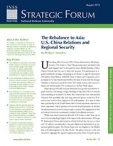Transitional Justice for Syria
Transitional justice is the provision of justice in the transition from one form of government, often perceived as illegitimate, unjust, and tyrannical, or an anarchic society, to one that observes the rule of law and administers justice. It also is about choices: how to allocate scarce prosecutorial, judicial, police, and prison resources. The goal is to make the rule of law ordinary. A 2004 report of the United Nations (UN) Secretary-General on the rule of law and transitional justice in conflict and postconflict societies observed that most examples of transitional justice involved states emerging from civil war or widespread civil unrest such that government became impossible:
|
05 февраля 2014
 The Rebalance to Asia: U.S. - China Relations and Regional Security The Rebalance to Asia: U.S. - China Relations and Regional Security
By Phillip C. Saunders.
About the Author:
Dr. Phillip C. Saunders is Director of the Center
for the Study of Chinese Military Affairs,
Institute for National Strategic Studies (INSS),
at the National Defense University and a Distinguished Research
Fellow in the Center for Strategic Research at INSS.
Upon taking office in January 2009, Obama administration officials proclaimed a U.S. “return to Asia.” This pronouncement was backed with more frequent travel to the region by senior officials (Secretary of State Hillary Clinton’s first trip was to Asia) and increased U.S. participation in regional multilateral meetings, culminating in the decision to sign the Association of Southeast Asian Nations (ASEAN) Treaty of Amity and Cooperation and to participate in the East Asia Summit (EAS) at the head-of-state level. The strategic “rebalance to Asia” announced in November 2011 builds on these earlier actions to deepen and institutionalize U.S. commitment to the Asia-Pacific region.
|
05 февраля 2014
The Rebalance to Asia: U.S. - China Relations and Regional Security
Upon taking office in January 2009, Obama administration officials proclaimed a U.S. “return to Asia.” This pronouncement was backed with more frequent travel to the region by senior officials (Secretary of State Hillary Clinton’s first trip was to Asia) and increased U.S. participation in regional multilateral meetings, culminating in the decision to sign the Association of Southeast Asian Nations (ASEAN) Treaty of Amity and Cooperation and to participate in the East Asia Summit (EAS) at the head-of-state level. The strategic “rebalance to Asia” announced in November 2011 builds on these earlier actions to deepen and institutionalize U.S. commitment to the Asia-Pacific region.
|
05 февраля 2014